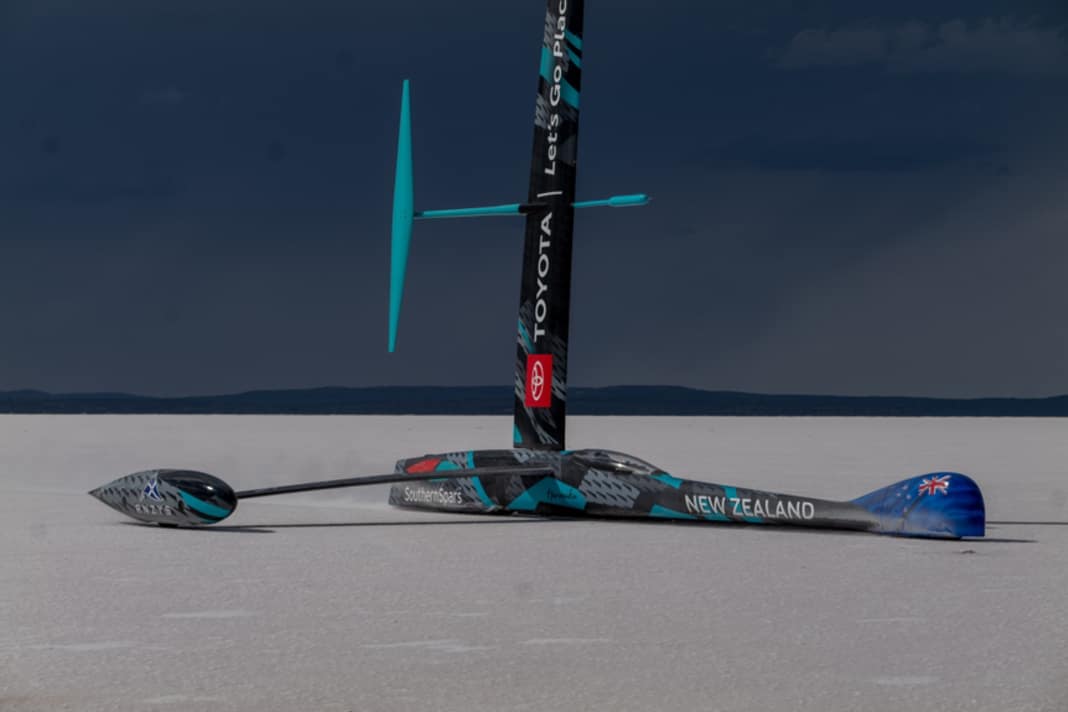





The New Zealand America's Cup -team reached a major milestone yesterday as part of their land speed project. Pilot Glenn Ashby managed to break the existing speed record of 202.9 kilometres per hour with the high-tech beach sailer "Horonuku". With only 22 knots of wind (40.7 km/h), the team recorded a breathtaking 222.4 kilometres per hour as the new top speed.
"We are obviously over the moon that we have sailed 'Horonuku' at a speed that no-one has ever achieved before," said the multiple America's Cup winner Ashby. After initial difficulties due to the weather situation, the New Zealanders came closer and closer to achieving their goal last week.
Record not yet official
Before the speed of 222.4 km/h can actually be considered an official record, a strict verification process must be carried out in accordance with the international umbrella organisation FISLY (Federation Internationale de Sand et Land Yachting). In addition, an independent judge was on site to witness and verify the run, the GPS recording and all other requirements of a record attempt.
The rules stipulate a natural surface for the record, so a tarmac race track is out of the question. For this reason, Team New Zealand chose the dried-out Australian salt lake Lake Gairdner.
The territory represents a significant difference compared to the previous record. British engineer Richard Jenkins developed a very similar-looking vehicle in 2009 and set a new record of 202.9 km/h. He chose a dry desert lake for his record-breaking run. However, he chose Ivanpah Lake, a dry desert lake, for his record run. In addition to the technical development by the New Zealand designers, this could also have been a decisive factor. At the very least, Lake Gairdner was deliberately chosen due to the extraordinary surface hardness of the salt.
Landspeed project not yet at an end
Since the last America's Cup the New Zealand team has been working on this special project off the water. Breaking the world record was only a sub-goal, but one that they were determined to achieve. "The Landspeed project was a new opportunity to push the boundaries of aerodynamics, structural forces, construction methods and materials," says Matteo de Nora, head of Emirates Team New Zealand. This is to be continued and pushed even further: "We know that we can go even faster, so that's what we intend to do."
Even the record-breaking race did not take place in ideal conditions. The sailors had to contend with water on the salt surface of the lake for months due to rainfall. This slowed down the 14.2 metre long vessel and sometimes even made tests impossible. The wind situation was also often anything but ideal. It is therefore hoped that much higher speeds can be achieved in better conditions. However, this is no longer expected this year.
Team New Zealand wants to be ahead of the times
"What is often underestimated is that the technologies we use in challenges like this - or in a America's Cup -campaign - are ultimately the basis for the technology of tomorrow," emphasises de Nora, referring to the other projects. Being ahead of the times technologically is the fascinating thing about all the challenges the team has faced so far. Among other things, it was the reigning America's Cup winner who launched the first prototype for the next Cup in 2024. The New Zealand team's development also serves as a yacht for all participants in the Youth America's Cup and the Women's America's Cup.
